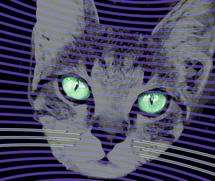Quantum cat's 'whiskers' offer advanced sensors

(PhysOrg.com) -- A team led by Oxford University scientists has turned one of the key problems with quantum entangled systems - that they are easily ‘disturbed’ by their environment - into an advantage which promises quantum sensors that are fundamentally more sensitive than their conventional counterparts.
Scientists attempting to build quantum computers have long been frustrated by the way that quantum entangled systems suffer from ‘interference’ from their surroundings. But now the Oxford-led team report online in this week’s Science that they have found a way to harness this sensitivity to create a system that responds to extremely weak magnetic fields - technology with potential applications in areas such as geological surveying.
The team built their system to exploit what is known as a ‘Shrödinger cat state’ named after the famous thought experiment by physicist Erwin Shrödinger: To show how the quantum world could affect our world Shrödinger imagined placing a cat in a sealed box with a lethal mechanism controlled by a random quantum event determining whether the cat was alive or dead. Quantum theory makes the remarkable prediction that until the box is opened the cat is both alive and dead. In the case of the Oxford work instead of all the molecules of a real cat being either alive or dead the ‘quantum cat’ is based on the nuclear spins of a molecule, trimethlyphosphite (TMP), being either ‘up’ or ‘down’.
‘To create our ‘quantum cat’ we took a star-shaped molecule with one central atom and nine atoms surrounding and applied radio frequency pulses to put it into an entangled state where all ten spins are spinning one way (‘alive’) and the other way (‘dead’) at the same time,’ said Dr John Morton of Oxford University’s Department of Materials, an author of the paper. ‘We found that compared to a non-entangled system our cat was many times more sensitive to the presence of a very weak magnetic field.’
Other proposed quantum-enhanced sensor systems use photons instead of nuclear spins to sense other physical quantities such as distance.
‘We are looking to turn experimental quantum systems into real world technology that people can use,’ said Professor Jonathan Jones of Oxford University’s Department of Physics, an author of the paper. ‘The next step is to investigate how a quantum sensor based on this work might be combined with existing sensors based on magnetic resonance.’
Such sensors are towed across the ocean floor looking for tiny, previously undetectable, telltale fluctuations in the Earth’s magnetic field which might suggest untapped reserves of gas or oil.
‘Many researchers try to make quantum states that are robust against their environment,’ said team member Dr Simon Benjamin of Oxford University’s Department of Materials, ‘but we went the other way and deliberately created the most fragile states possible.’
Provided by Oxford University (news : web)

















